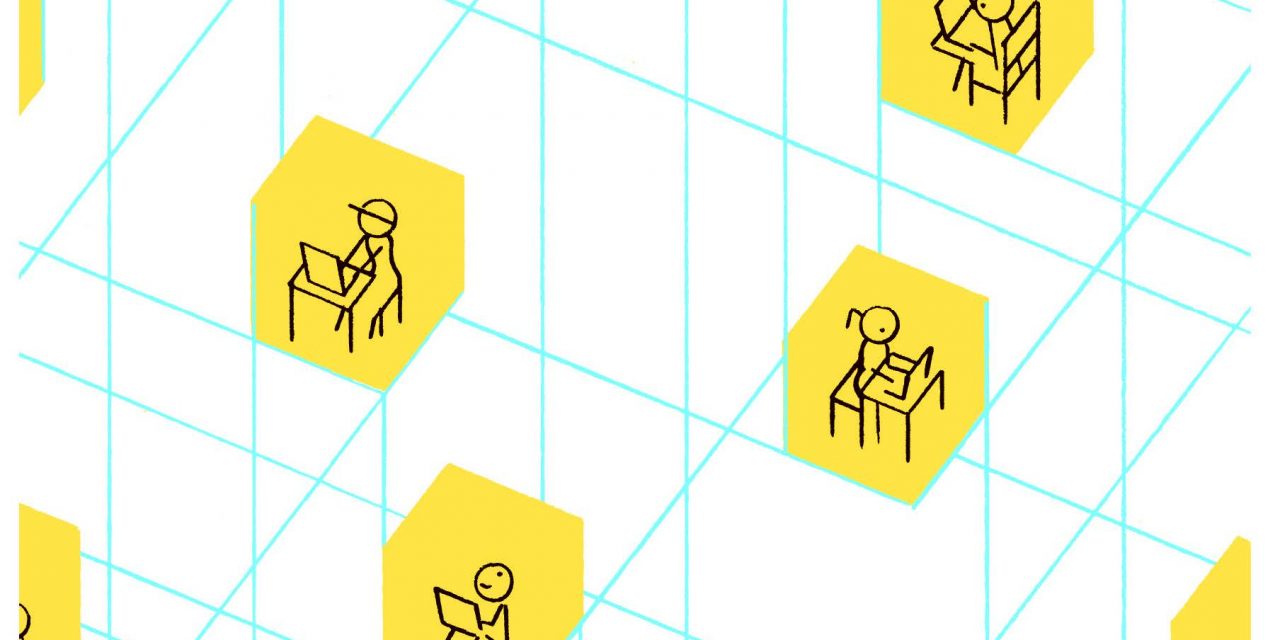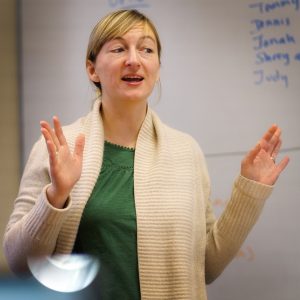
A Different Kind of Classroom

– As Milton shifted to remote learning last spring, History Teacher Katharine Millet ’00 and her students discovered new ways of teaching, learning, and remaining close. –
 “How likely is it that we will come back after spring break, Ms. Millet?” A student looked up at me from her seat at the Harkness table—curious, but not worried. “I don’t know,” I said,“but I suspect we will probably come back on time.” That was Monday, March 9, 2020. By Wednesday, the prospects looked more dire, and by Thursday night, the administration had made the decision to start spring break a day early.
“How likely is it that we will come back after spring break, Ms. Millet?” A student looked up at me from her seat at the Harkness table—curious, but not worried. “I don’t know,” I said,“but I suspect we will probably come back on time.” That was Monday, March 9, 2020. By Wednesday, the prospects looked more dire, and by Thursday night, the administration had made the decision to start spring break a day early.
Most teachers like to have the answer. To be informed enough to respond to their students’ daily questions or to point young scholars toward the proper path of investigation. Yet we also have to be comfort- able with not knowing. We have to model what learning looks like in order to inspire those in our classes to keep doing it. We have to insist, too, that often there is no single “answer.” Not knowing, along with our students, and exploring together, is an integral part of the learning journey. When Covid-19 hit the United States in force, and Milton Academy shifted online, our full community was thrown into the unknown. We had to learn digital platforms and how to connect with our advisees over a screen; we needed to moderate discussions with the inevitable connection lags; we were forced to scrap time-tested lesson plans and start afresh. Many of us experienced this academic change while also facing various degrees of upheaval in our personal lives—the illness of, pass- ing of, or even just separation from, dear family and friends; the shift to caring for and educating our children or younger siblings from home; the absence of usual health and wellness routines and appointments; and/or the loss of employment or regular income streams our households de- pend on. As many noted during this time, we were entering crisis teach- ing in a time of global pandemic, not simply “going digital.” Not even the most intrepid among us would have chosen this level of challenge, but we all had to face it.
When looking into the unknown, students and teachers alike rely on two things: the knowledge they do possess and the skills and competencies they have already acquired. What I knew in March 2020 was that students learn best when they feel connected to their teacher and class- mates and that sticking to known platforms and routines would sup- port my students, regardless of the circumstances in which they found themselves. I also knew the basic structure for the spring. The Deans’ Office surveyed all students about their access to technology and the internet, along with their current time zone, and assigned each class a weekly meeting slot for synchronous gatherings. Teachers’ “office hours” for individual and group questions were also established and distributed to students. With these touchstones in place, we forged ahead.
Begin with connection. Numerous studies, and personal experience, have convincingly demonstrated that relationships are at the heart of the most durable and meaningful learning.Thankfully, our students were not new to us when we began teaching remotely. We had already established norms and a classroom culture, along with a sense of trust. Coming back to school after an ex- tended spring break, my students were initially assigned to contribute to a discussion board, each of them posting a video answering questions such as: “What was one thing you thought you would never get sick of (but were SO wrong!)?” and “What do you appreciate so much more than you did before quarantine began?” It was wonderful to see students’ faces and hear their voices again, and to learn more about their individual interests. I posted my own videos as well, and let my students know about my dog’s passing in March, which prompted several heartwarming notes of condolence. Each week ended with a survey asking both “How am I doing?” and “How are you doing?” which allowed me to improve my approach in two ways— responding to my students’ feedback, and responding to individual students’ current state of mind.
Rely on routines. Since September, my class has always begun the same way: with a “First Thing.” Up on the whiteboard, as students trick- led into the room, would be a short task to start the day. “Pick a quote from last night’s reading to discuss with a partner,” or “Can you come up with a pop culture example of each of the forms of Greek love?” When our Zoom classes started up in April, I continued the practice to reinforce our class dynamic. One week I asked students about creative outlets they’d discovered (or rediscovered) during their weeks of isolation. They shared their short comedic films, paint-by- number canvases, cookie recipes, photography experiments, and newly memorized guitar melodies. I, for one, treasured this familiar structure as a way to make Zooming feel less distinct from our previous way of being together. Following established routines like this one, and using common tools like Schoology, our learning management system, was a way to create a baseline of normalcy in a highly abnormal situation. As a teacher of two freshman his- tory survey courses, I had a single academic objective for this spring: to help my students complete their Class IV research papers. As a department, we extended the length of time allotted to the assignment, and as a school, we pivoted to a pass/ fail grading system. This freed my students and me in many ways and possibly produced even better papers overall. Students were able to design their own schedule and pace for meeting weekly expectations. They chose topics of personal interest and identified the hours and settings in which they could be most productive. Some faced great personal hardship during that time and were able to tend to self-care first and catch up later. The grace we gave one other during the spring was beautiful, frankly, and something we all should carry forward. During a pandemic, it became strikingly clear that academic growth cannot happen before safety, relationship, and communal support. We have all been forced to recognize the differences of circumstance that impact our students’ abilities to learn and the burdens they carry beyond the amount of homework they have. We have opened our lives to one an- other in new ways, and perhaps the doors should not fully close when we resume again.
Much is still uncertain about the 2020-2021 school year, but I know my first priority come September is to get to know my students. Doing so over the internet is a novel challenge but I have the lessons of this spring guiding me. I will create spaces for learning that transcend classroom walls. I will be more attuned to my students’ emotional states and ex- tend more grace. I will acknowledge that growth looks different and hap- pens at different times for individual kids. I will worry less about assign- ing numbers and letters to student work and focus on providing meaningful feedback that contributes to learning. Covid-19 has forced us to reevaluate what we know our School to be and has helped clarify what is essential and what is not. And if we do not learn and grow from this experience, then exactly what message are we sending our students?




